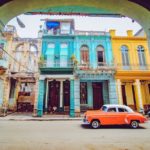The Quest for Cuba in a Cup

It’s the aroma: the robust, strong scent of Cuban Arabica coffee that made me go for Nespresso’s “Cafecito de Cuba.” For months I’ve bought sleeves of the coffee pods, looking forward to waking up to the smell of Cuban coffee. This was all quite unusual, I thought, as I’m hardly a coffee person. I prefer tea. Nespresso’s offering, dubbed “Cuba in a cup,” has powerful yet delightful smoky notes of wood and tobacco leaves. Its limited edition status makes it very desirable. When supplies finally ran out, auction sites started selling them at ridiculous prices. One might as well go to the coffee beans’ island of origin, I thought.
Thus began my journey to Havana. In a state of caffeine-induced wanderlust, I booked a flight. JetBlue just started direct US-Cuba flights for the first time in 50 years. It’s historic and I wanted to be part of it. I also just fancied a cup of Cuban coffee. Never mind that I couldn’t convince anyone to accompany me, or that my boss wouldn’t give me the time off for this unplanned trip.
For over 50 years the Caribbean island of Cuba has seemed like a myth to Americans. While the rest of the world enjoyed its charms, Americans weren’t technically allowed to visit as tourists. To enter with an American passport you still need a license. The Office of Foreign Assets Control (OFAC) of the Treasury Department list 12 categories, including family visits, journalistic activities, educational, humanitarian and athletics, and support for the Cuban people, among others. Airlines flying into Cuba will ask you to choose a category and sign an affidavit prior to making final purchase of plane tickets. Expect to pay $50 for a travel visa at the departure gate.
In a state of caffeine-induced wanderlust, I booked a flight to Havana.
On a wet January morning I flew from San Francisco to Havana via Fort Lauderdale, Florida. It’s less than an hour flight time to Havana from Florida but it feels like a lifetime when you get there. At Jose Marti International Airport, a couple holding a sign with my name on it beckoned. Since I was traveling alone and didn’t know anyone in Cuba, I arranged my accommodation through AirBnB and requested my hosts for an airport pick up. “Bienvenida a la Habana, Welcome to Havana,” my hosts smiled and hugged me. It felt a bit like coming home.
It’s a pleasant drive to the leafy Vedado area where I was staying. Vedado was once a prestigious area with many neoclassical mansions. Today, it’s Havana’s modern political and cultural center as well as its historic link. On the way I noticed classic American cars on the road. They were big, colorful, and clunky. They also reminded me of characters in a period film, smoke coming from their exhaust pipes, like Prohibition-era gangsters puffing their cigars. I noticed billboards everywhere. In America, these would’ve been commercial advertisements. In Cuba, signs read such things as “Salud Para Todos” (Health for All).
Arriving at the apartment, my hosts–a mother-daughter team–graciously showed me my room. Later, they left me to my own devices. Literally. With an iPad, I Googled my way to the perfect Cuban coffee.
I noticed classic American cars on the road. They were big, colorful, and clunky. They also reminded me of characters in a period film, smoke coming from their exhaust pipes, like Prohibition-era gangsters puffing their cigars.
Coffee is very much a part of Cuba’s national identity. The beans first came to the island in the mid-1700s. At its peak, Cuba was a major coffee exporter. Production soon declined post-revolution. The government gives Cubans a monthly ration. Due to limited supplies, the quota is cut with ground Chicharo beans, a garbanzo-like bean. It comes across as an earthy, rustic, and slightly bitter brew. The island’s coffee culture exudes a sense of unity and pride. When Cubans drink coffee, it’s a social event, a way to come together.
Searching for the ultimate brew, I noticed there were hardly any established coffee shops except in the popular La Habana Vieja (Historic Center) of Havana. No Starbucks. Locals buy their coffee at a window called ventanilla. In the Historic Center, Cafe Reilly caters to tourists but can be pricey. Eventually, I did try an authentic Cuban coffee.
Near the Paseo del Prado, one of the world’s most elegant boulevards, I was served cortadito, a standard espresso shot topped off with steamed milk. Here, in a converted mansion-turned-restaurant, I delightfully sipped Cuba’s black gold. It’s my first memory of Havana: rich, aromatic, bittersweet and delicious. I definitely could come back for more.
Photo by Unsplash.com.









Wow ingrid congratulations since highschool you love to write . Were so proud of you keep it up. GOD BLESS you always in your journey .. .. 🙂